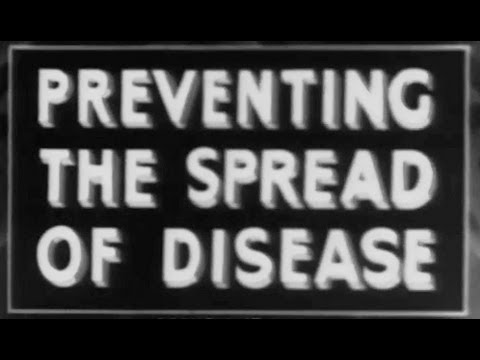more at
‘Shows how communities can prevent the spread of disease by providing safe water and milk supplies, sewage disposal facilities and anti-fly measures. Shows how individuals can protect themselves by keeping away from sick people, vaccinating whenever possible, securing medical care promptly when ill, and by building up body resistance through good nutrition, exercise and sufficient rest.
Ken Smith remarks: “Every step taken to prevent the spread of disease means increased happiness and greater living efficiency for all of us.” This strange little film first introduces us to “poor Barbara,” a bedridden little girl who is “miserable with suffering and pain.” Suddenly, the screen is filled with Dutch angle shots of marching troops. “Her body is just like a little country that has been invaded by an enemy army!” the narrator cries. “Except its soldiers are the germs of communicable disease!”
Poor Barbara is forgotten by the makers of this film at this point, and we are treated to a series of shots of frozen-faced people who are obviously very uncomfortable in front of a camera. One little girl and boy stand with the words “sick” and “well” pinned to their clothes. A woman with too much eye makeup sneezes and then a hand-held pointer edges tentatively into the frame, indicating where her spray traveled. Totally unrelated waltz music plays on the soundtrack. We are told to use screens, cleanliness and paper cups as two children run away from a door posted with a sign that reads “Scarlet Fever.”
Not a very coherent film, but certainly fun to watch’
Public domain film from the Prelinger Archives, slightly cropped to remove uneven edges, with the aspect ratio corrected, and mild video noise reduction applied.
The soundtrack was also processed with volume normalization, noise reduction, clipping reduction, and/or equalization (the resulting sound, though not perfect, is far less noisy than the original).
Infectious diseases, also known as transmissible diseases or communicable diseases, comprise clinically evident illness (i.e., characteristic medical signs and/or symptoms of disease) resulting from the infection, presence and growth of pathogenic biological agents in an individual host organism. In certain cases, infectious diseases may be asymptomatic for much or even all of their course in a given host. In the latter case, the disease may only be defined as a “disease” (which by definition means an illness) in hosts who secondarily become ill after contact with an asymptomatic carrier. An infection is not synonymous with an infectious disease, as some infections do not cause illness in a host.
Infectious pathogens include some viruses, bacteria, fungi, protozoa, multicellular parasites, and aberrant proteins known as prions. These pathogens are the cause of disease epidemics, in the sense that without the pathogen, no infectious epidemic occurs.
The term infectivity describes the ability of an organism to enter, survive and multiply in the host, while the infectiousness of a disease indicates the comparative ease with which the disease is transmitted to other hosts.[2] Transmission of pathogen can occur in various ways including physical contact, contaminated food, body fluids, objects, airborne inhalation, or through vector organisms.
Infectious diseases are sometimes called “contagious” when they are easily transmitted by contact with an ill person or their secretions (e.g., influenza). Thus, a contagious disease is a subset of infectious disease that is especially infective or easily transmitted. Other types of infectious/transmissible/communicable diseases with more specialized routes of infection, such as vector transmission or sexual transmission, are usually not regarded as “contagious,” and often do not require medical isolation (sometimes loosely called quarantine) of victims. However, this specialized connotation of the word “contagious” and “contagious disease” (easy transmissibility) is not always respected in popular use…
Prevention
One of the ways to prevent or slow down the transmission of infectious diseases is to recognize the different characteristics of various diseases.[4] Some critical disease characteristics that should be evaluated include virulence, distance traveled by victims, and level of contagiousness…
Another effective way to decrease the transmission rate of infectious diseases is to recognize the effects of small-world networks. In epidemics, there are often extensive interactions within hubs or groups of infected individuals and other interactions within discrete hubs of susceptible individuals. Despite the low interaction between discrete hubs, the disease can jump to and spread in a susceptible hub via a single or few interactions with an infected hub…

